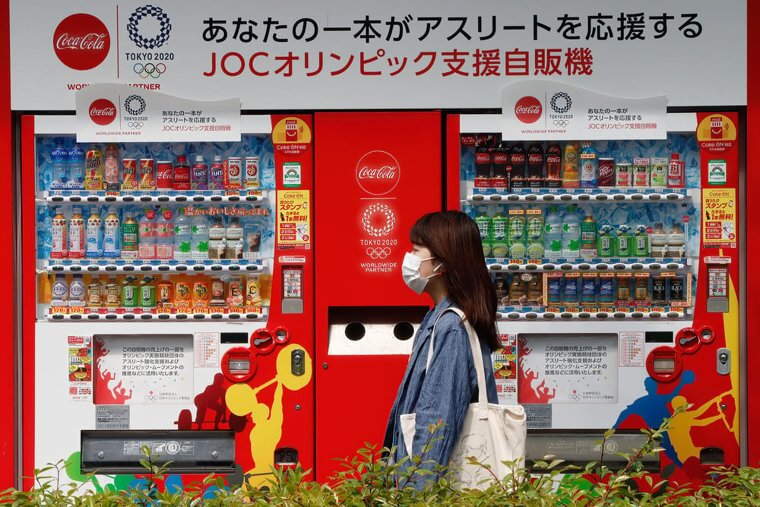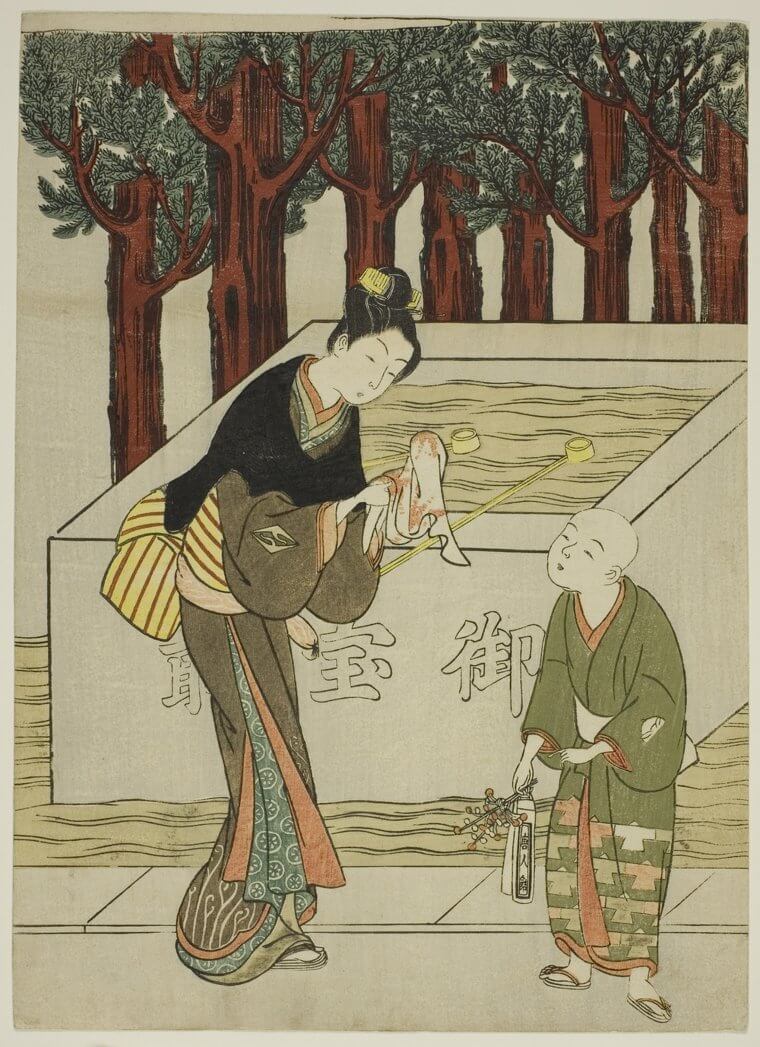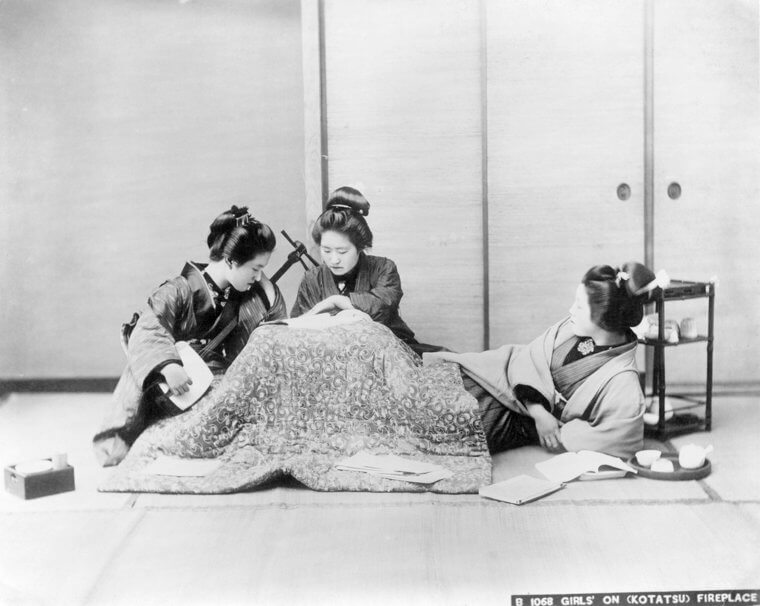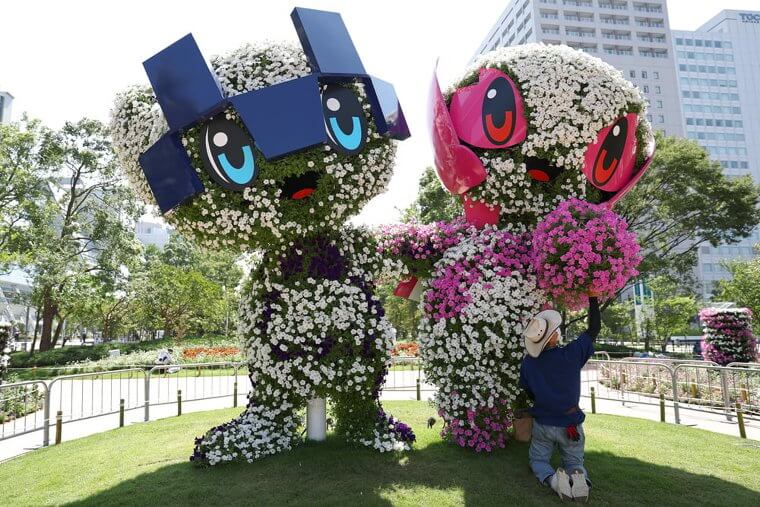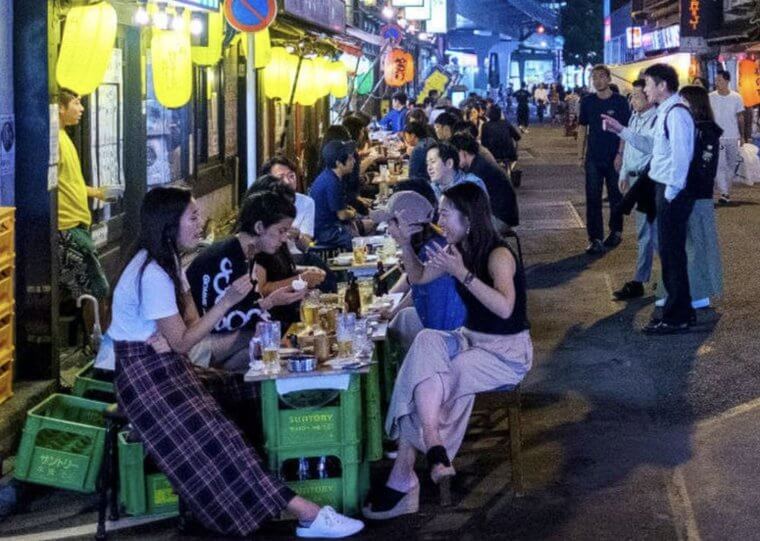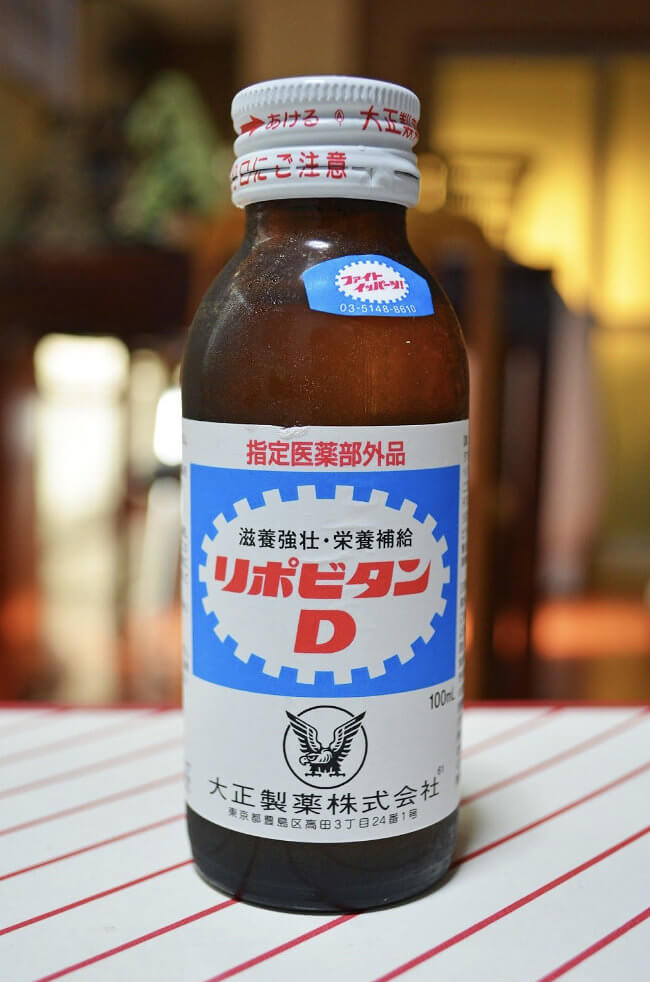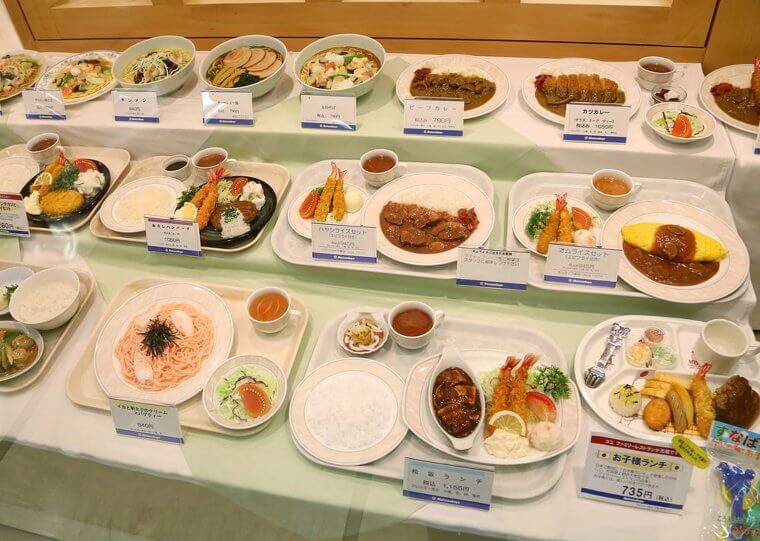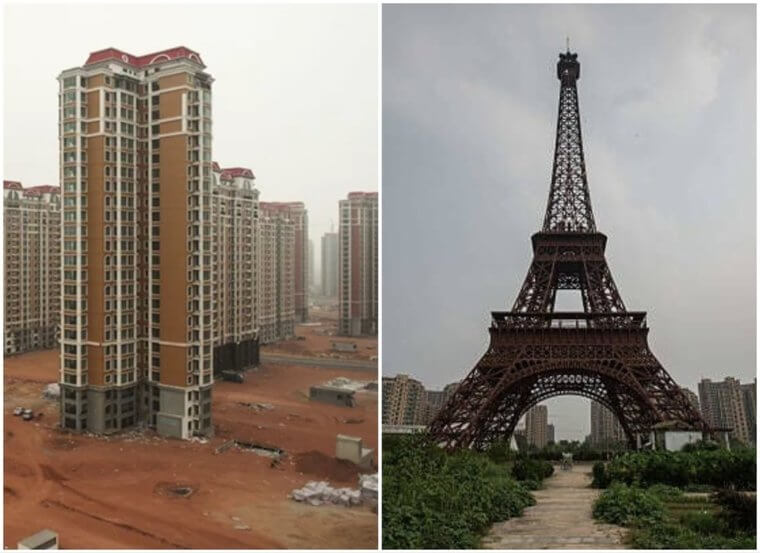Japan is famous for bonsai trees, sushi, and Tokyo’s bright lights, but there are some slightly stranger things that are unique to this island nation. Fascinating tidbits like maid cafes, lighting fast bullet trains, futuristic toilets, and miniature pod-like hotels are but a few such Japanese specialties. For more examples of Japan’s quirky and eccentric style, read on to learn things you'd only find in the State of Japan.
Convenience At The Push of a Button
Japan has one of the highest vending machine densities with about one machine for every 30 people. You will find these machines in every station, all over the cities, and even in the countryside! Almost none of the 4 million or more machines are damaged or vandalized. While the sheer number of these convenient machines is staggering, what they sell also grabs our attention.
For a reasonable price, you can treat yourself to a non-alcoholic drink of your choice, which is what the majority of Japan’s vending machines offer. Hot and cold beverages like juice, soft drinks, tea, coffee, and energy drink will usually be available. Machines offering cigarettes and alcohol are less common and would require an ID for purchases. However, you can also find in instant noodles, ice cream, umbrellas, milk, disposable cameras, and more!
Toilet Time Is a Treat
Japanese-built toilets also go by the name super toilets and smart toilets. They are manufactured with smart technology – they use water efficiently and can clean themselves! These toilets usually come with a control pad that might be complicated to master at first. However, with some practice, you can enjoy temperature-controlled water sprays for your backside, sounds to cover any noises, heated seats, dryers, and lovely perfumes!
The largest manufacturer of these marvelous toilets is a Japanese company called TOTO. In 2017, the company reported profits of $311 million, mostly from their patented 'Washlets' sales: electronic bidets built into toilet seats. They can be found in 70-80% of all homes in Japan.
Hundreds of Kit Kat Flavors
Nestle’s Kit Kats are popular worldwide, but Japan takes the cake for creativity when it comes to the flavors you can find. In 2004, Nestle released a popular green tea flavor, as well as 300 other Japanese Kit Kat flavors including wasabi, cheesecake, yogurt, sake, pudding, and apple to name but a few.
While the variety of flavors is enough reason for the Japanese to enjoy these wafer chocolates, there is another reason why Kit Kat might be so well loved. In Japanese, ‘good luck’ is pronounced as ‘kitto katsu’, which sounds very similar to the Japanese name for Kit Kat, which is ‘kitto katto’. Rumor has it that the chocolate bar is considered a sign of good luck in Japan.
Hotel Rooms From the Future
Capsule hotels were originally built as an affordable place for salarymen to stay after a day’s work. These unique ‘hotels’ provide lower-priced accommodation that caters to a wide range of customers. Since these capsule hotels are not technically seen as real hotels, pods cannot be locked, but there will always be a storage room or locker where you can keep your belongings safe.
These compact sleeping quarters provide a futuristic take on accommodation and with Japan’s large population, they are a convenient alternative to hotel rooms which are more expensive. While these pods are cheap and simple, they do provide a comfortable night’s sleep. Many of these capsule hotels also offer television, food service, shared baths, and entertainment rooms. They're actually becoming an inspiration for modern hotels worldwide.
Refresh Your Hands Before a Meal
If you haven’t heard of an ‘oshibori’ before, don’t worry – it’s pretty simple! It is a small white towel (about the size of a washcloth) that has been soaked in hot or cold water and then lightly wrung out. The towel will then be damp, but not dripping with water before being folded. Though a popular way to treat VIP guests nowadays, this ritual originated in Japan.
In Japan, it is customary to clean your hands before a meal with an oshiburi. They are usually placed beside you on the dining table and are extremely useful for wiping your hands in the comfort of the table before indulging in your main course.
Impressively Enormous Rice Art
Rice paddy art was made famous by the town of Inakadate and these natural illustrations can now be seen regularly from the months of June to October. The pictures are created by planting different colors of rice by hand so that it will display an image when looked at from above. The trend started in 1993 when a brand of rice did it as part of a promotional campaign. Since then, it has developed into a national tradition.
Because of the uniqueness of the art, it has drawn media attention both domestically and globally. More than 100,000 visitors come from near and far to look at the fields every year. Impressively detailed pictures of Marilyn Monroe, Audrey Hepburn, Godzilla, and many more have been created.
Cute but Durable Schoolbags
‘Randoseru’ backpacks are firm-sided bags that are made from stitched leather or other leather-like materials and these backpacks are usually very pricey. In Japan, you will see elementary school children sporting these packs which are a six-year investment for their entire elementary school careers. It forms part of the family budget as a child traditionally receives a randoseru backpack when they start school.
Though cute, their design comes from a European-inspired military backpack that was popular during Japan's Edo period between 1603 and 1867. The name of these bags for schoolchildren actually comes from the Dutch word for a backpack which is “ransel”. Nowadays, The Institute for Traffic Safety is attempting to supply yellow covers for the randoseru backpacks to increase children’s visibility in traffic.
A Fireplace Alternative for Winters
Most homes in Japan don’t have insulated walls or central heating systems, but most of them have a kotatsu. It’s similar to a fireplace as it's the center point of attraction for people to huddle around. They have been part of Japanese culture for centuries and, though decreasing in popularity with the invention of underfloor heating, they are more efficient when it comes to energy-saving.
These days, a kotatsu comprises a low table with a futon-like blanket (shitagake) placed over it. Beneath the table, there is an electric heater built into it that provides a warm and toasty hideout for your lower body on those cold winter days. Before the middle of the twentieth century, charcoal was used as a heating source. While these winter warmers are almost exclusively used in Japan, Iran and Spain have similar warming concepts.
Blue Light Means Go
In Japan, drivers stop at red traffic lights, but they go when the light turns blue. Yes – blue, not green! This is because, in ancient Japanese, the words blue and green were the same. Both colors were often described by the word “ao” which means “blue” in English. Nowadays, the word “midori” is used for the color green, but for the traffic light system, the earlier culture is observed.
The International Commission on Illumination says that the color of Japanese traffic lights is a shade of green that is very close to the color blue and the first Japanese traffic lights were labeled “midori” (green) by law. Eventually, the official definition was changed to “ao” (blue) as a result of more people saying this color.
Rooms by the Hour
Japan is famous for its ‘love hotels’ which can easily be spotted by their hourly rates. These quirky and mysterious hotels are the answer to a rare commodity in Japan – privacy. With inquisitive neighbors, intrusive parents, and tiny apartments, it’s difficult to invite a partner over for some intimate time. Partners can enjoy discreet romantic time together with guaranteed privacy.
Most love hotels are happy to open their doors to foreigners and one shouldn’t feel awkward when walking into such an establishment to rent a room. These hotels were born out of necessity as the Japanese are not as publicly open about sex as other cultures may be. Love hotels started booming in the 1980s and nowadays provide essential comforts like large beds, nice bathrooms, and televisions with adult programs.
Compulsory Appetizers
When you visit a Japanese restaurant or an izakaya (Japanese-style pub), you can expect them to serve you otoshi. These small plates of quick nibbles can even be served immediately as they are often pre-prepared. Otoshi are most commonly served on a small plate and edamame beans are very popular ones, as well as offal stew, potato salad, and spicy octopus.
Your otoshi will sometimes arrive with your first alcoholic drink or as soon as you sit down at your table. It might appear similar to France’s amuse-bouche, but otoshi is not complimentary. These compulsory appetizers will be added to your bill as a type of seating charge.
A Different Address System
If you’ve seen a Japanese address, you will know that they are puzzling. Japan’s roads were built in maze-like patterns centuries ago, making it complicated to name roads for address purposes, so they follow a different system. Rather than naming streets, they have split different neighborhoods into separate blocks called “chomes”. This means that some homes will share an almost identical address!
In an effort to help the mailman find your home, most homeowners will have a personalized nameplate called a “hyosatsu” to identify their address. These hyosatsu will most commonly be the name of the homeowner in Japanese or English. Some homeowners may design lavish and costly hyosatsu as a symbol of their status.
Mascots Are Popular Among the Population
In Japan, “Yuru-kyara” are mascots that help draw attention to promote tourist attractions, towns, or regions for example. You will see them all across the country and while some are sweet and funny, others might seem totally peculiar. Domo-kun and Kumamon are two of Japan’s most iconic Yuru-kyara and they are both known globally. In fact, Kumamon generated 124.4 billion yen for the province of Kumamoto in a matter of two years!
One theory as to why mascots are so popular in Japan is due to the historical emotional bonds that the Japanese have had to non-human characters as they did in ancient polytheism. In Japanese folklore, there are also many different yōkai (supernatural entities and spirits) and some of these have been the inspiration behind many Yuru-kyara designs.
Japanese Happy Hours
In Japan’s bars and casual restaurants, Nomihodai is a common menu option that is widely available. Nomihodai translates into “All you can drink” in English and it is a fun and affordable way to drink without breaking the bank. Usually, the price for Nomihodai is roughly ¥1,500, $10, to drink as much as you want within a time limit.
Generally speaking, the time limit for Nomihodai will be about 1.5 – 3 hours and the time starts when you order the first drink. Your waiter will deliver your drinks to your table, which saves a lot of time! Be sure to bring some friends as Nomihodai isn’t usually for singular customers.
Is It a Photo Booth or Photoshop?
Japanese youth, especially females, enjoy visiting "purikura" photo booths. Japan took photo booths to the next level with purikura as you can also edit and decorate the pictures before printing them as stickers. Popular effects that purikura booths offer include eye-widening, make-up, weight loss, and skin tone adjustments.
You can also put notes, colorful stickers, and the date on your photos to customize them further. These quirky photo booths can be found throughout Japan at places where the younger generation enjoys spending time like karaoke establishments, department stores, amusement parks, and arcades. You could even find places that have a whole building floor only for purikura machines!
Energy Drinks Galore
There is a massive market for energy drinks in Japan as they are a society that spends a lot of time working long hours. Appealing energy drinks are stocked throughout Japanese convenience stores and supermarkets, but many of them actually come in smaller bottles, mimicking medical tonics and they are usually packed with nutrients and vitamins.
Lipovitan D, pictured above, is arguably one of the most popular such drinks and it was introduced by Taisho Pharmaceuticals back in 1962. This energy drink is filled with vitamin B, taurine, inositol, and caffeine, providing tired workers and sleep-deprived partygoers with their needed emergency energy source. It helps with mental and physical stress which is why it is loved by so many.
It’s Common Practice to Wear a Mask
When the Japanese trees, like cedars and cypresses, release a lot of pollen in the air, or when it’s winter and influenza is making the rounds, the Japanese tend to wear masks daily. Before the Coronavirus, the Japanese population wore masks regularly. This habit likely started after the outbreak of influenza back in 1918, in which Japan was heavily affected and around 400,000 people died.
The demand for masks continued growing when there was another outbreak of flu in 1934 as the nation wanted to wear them to protect themselves. After that, the Japanese turned to masks each time there was an outbreak of influenza and it became customary to wear a mask when you had a cold or felt unwell.
It’s Acceptable to Drink in Public
In most countries, public drinking has been banned (and for good reasons), but in Japan, this is not the case. There, you will see college students getting together for drinks in parks, travelers buying beers for their train rides, and even parties in the streets of nightlife districts like Roppongi and Shibuya. Thanks to Japanese manners, it’s safe to have a good time in the streets at any time.
The legal drinking and smoking age in Japan is 20. However, drinking forms an integral part of Japanese work and social culture since it facilitates breaking down the stiff appearances that are part of their culture. In Japan, drinking is seen as a way to connect through a sense of honesty.
Foot Baths for Free
If you visit towns with hot springs in Japan, you will see ashiyu (foot baths) on many street corners. They are easily accessible since you do not have to remove all your clothing to enjoy the hot spring water as you only immerse your legs up to your knees. You will also see them at rest areas, parks, and railway stations. Most foot baths are completely free of charge.
Even though you are only submerging your feet in warm water, it can warm the rest of your body thanks to the large veins running through your legs. As you can imagine, you need to take your socks and shoes off before using a foot bath, and rolling your pants up to the knees is the easiest approach. But unlike when using a hot spring, you don’t have to wash your feet before entering the bath.
Tasty-Looking Fake Food
In Japan, restaurants will often have realistic models of the dishes on their menu on display to show people what they can prepare. This method is very handy for people who can’t speak Japanese or just to help indecisive guests choose the right meal to avoid food envy. It works so well that this practice has spread overseas to other countries too.
The food models (shokuhin sampuru) which are also known as food samples or fake foods are replicas of a menu item that’s usually made from wax, plastic, resin, or another similar material. If you pass a restaurant in Japan and see tasty food on display in the window, that food is not for eating! It should give you a realistic idea of what you can eat there and hopefully, entice you to come inside.
Very Few Trash Cans
Japan has very strict rules regarding recycling and waste disposal, which is why you won’t see many trash cans around the cities, yet it is kept so clean! The reason for this is that many Japanese people will keep their garbage until they find the right place to dispose of it. While it might sound inconvenient, it is a system that seems to work.
The country’s lack of trash cans in public areas might appear to be a direct contradiction to the otherwise super-convenient qualities of the state. Most trash cans cater to vending machine waste which is mostly cans and plastic bottles for recycling. One reason for the decrease in trash cans is their removal after the Tokyo subway attack in 1995 in an effort to counter terrorism. Instead of being annoyed, rather be aware and take responsibility for your waste as it impacts the environment.
Expensive and Exotic Fruits
If you have ever visited a supermarket in Japan, you would likely have noticed the exorbitant prices of their exquisite fruits. Some reasons for these high prices are that local farmers are motivated to produce fruit that will make their region proud. Fruit is seen as a luxury gift in Japan, so farmers aspire to grow premium fruits.
Besides regular fruits, Japan also produces some exotic and iconic ones like its square watermelons which can cost $140 each. They also grow a Densuke Watermelon which is jet-black and has sold for a record price of $6,000! Watch out if you are a grape lover – Ruby Roman grapes are each the size of a ping pong ball and their price starts at about $365 per bunch.
Terrific Trains
Taking a ride on one of Japan’s themed trains could be more exciting than the destination of the train itself. Japan Rail’s Joyful Trains have fun and exciting themed rail cars and you can expect to be entertained by the themed trains’ fun activities, unique décor, and impersonations of cute characters. For history lovers, there are restored trains that will take you on a trip back through time.
Some popular trains include the Toreiyu Tsubasa which has viewing windows and footbaths to enjoy as you watch the breathtaking scenery of Yamagata and Fukushima roll past. For anime enthusiasts, you can take a ride on the “Pokémon with You” train. Other awesome features to be found on board Japan’s unique trains include playgrounds, sake tasting courses, kotatsu seating, wood fireplaces, open roofs, and more!
Butler and Maid Cafes
If you want to experience the pinnacle of “weird Japan”, why not visit one of their maid or butler cafes? It won’t be hard finding one in the streets of Tokyo where customers visit these cafes for a unique experience. Expect exquisitely dressed maids or butlers who will sing and dance for you while you enjoy your meal. They also serve cute dishes with saucy illustrations to top them off.
These cafes started as a subcategory of cosplay restaurants where customers can enjoy the novelty of being treated like a master or mistress as if they were in their private mansion. Be advised that photos of the staff are not permitted as they will generally be charged as an extra service. Pictures of your food, on the other hand, are welcome.
Two Romantic Days a Year
On the 14th of March each year (exactly one month after the internationally celebrated Valentine’s Day), Japan celebrates White Day. On this day partners (usually men) will buy chocolates for their loved ones who spoiled them a month earlier and if they know what’s good for them, they will reciprocate with a larger gift!
This tradition of reciprocal gifts began in Japan in1978and it has since become popular in other Asian countries as well as more countries worldwide. It also gives you the opportunity to hand out “obligation chocolate” (giri choco) in the form of more affordable treats to your friends and coworkers.
What’s It Like to Live in China? These Pictures Reveal All
China is known to be one of the most mysterious and interesting countries in the world. Besides being a very prolific manufacturer and an economic giant, this country has an extraordinary culture that runs back thousands of years ago. Yet, some of the traditions of the Chinese people may seem odd, even offensive, to Westerners. Let's get to know some of the most unique Chinese societal norms.
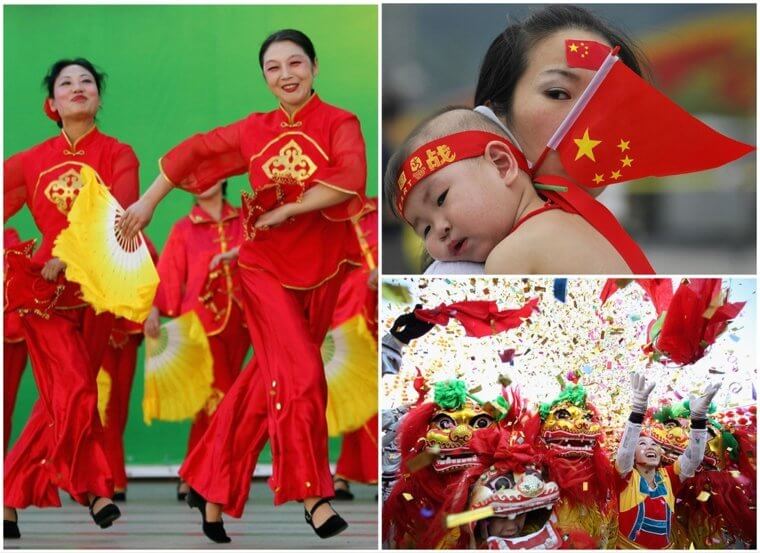
This Unusual Sculpture
If you visit China, it is likely that you will run into some attractions that would be considered "out there". Dubbed one of China's ugliest buildings, this sculpture, built into a building, is a sight you shouldn't miss. These three giant figures stand 3-stories high along one side of the Tienzi Hotel in Hebei, China.
You're probably wondering—who are the three people that were honored with such a tribute? They are Shou, Fu, and Lu, mythical heroes in Chinese culture who represent good health, good luck, and fortune, respectively. The vibrant dresses and interesting held pieces make this a very unique attraction. Face it—where else can you look up and see this huge and oddly mesmerizing sight?
Paws and Paintbrushes
If you look at this photo at a quick glance, you could think this woman is walking a tiger and that the girls are holding three adorable baby pandas. Would you believe us if we told you they are all dogs? You should, because apparently, it is a trend in China to design and paint your pet into a different animal. It's a unique way for pet owners to showcase their creativity and give their furry friends a playful twist.
We're pretty sure the animals themselves could enjoy a day of getting groomed and pampered all day. However, we probably would feel bad turning our own dog into his biggest nemesis—a cat. If they knew what we were doing, we think they may never forgive us...
Sun-Blocking Styles
When we go to the beach, we're likely hoping to get a bit sun-kissed with a natural tan. In China, however, the standard for beauty is often different than in Western cultures as they consider lighter complections more traditionally beautiful. That's why in this photo you can see these Chinese beach-goers wearing an interesting and intense choice of face wear.
Known as a "facekini", these facemasks must be a very good protector from the sun and may also help in reducing the rates of skin cancer. However, we believe that a hefty amount of sunblock with a high SPF should be enough to do the job, and might make for a more comfortable option in a hot and sunny day.
China’s Property
Did you know that pandas are actually owned by the People’s Republic of China? This means the country owns every existing panda on the planet today. Every time you visit a zoo and enjoy the antics of pandas, no matter where in the world you happen to be, don’t forget to give credit to China.
China regularly lends out its pandas to zoos all over the world. However, they have a strict rule that any newborn pandas outside of China must be immediately sent home to widen the gene pool. It was only recently that the species’ status changed from endangered to vulnerable. Their survival is thanks in large part to China’s special panda breeding facilities.
Craze-Tea
Even In the far-east country of China, we would probably still find the big and known businesses that we see in the West. But sometimes, they can appear with a special twist. Ever heard of Starbucks? Well, Say hello to Teabucks. As the name suggests, this place specializes in tea.
We like the idea of taking something known and changing it up to make it fit the culture. It's likely they chose the household name as inspiration to attract visitors from around the world. Well, it's working on us! We would love to visit and see what types of tea they have to offer us.
Family Planning Certificate
China’s controversial one-child policy was the reason why two people in love couldn't just decide for themselves to have a baby – well, at least not without their government’s approval. If they’re residing in China, couples were required to apply, get approved, and receive a family planning certificate before having a baby.
The sad thing was that if you don’t get approved for the family planning certificate and decided to have a baby anyway, your child was considered illegal, the Chinese word for which is "heihaizi". These children were unable to receive the Chinese version of social security numbers, meaning they couldn't be treated at hospitals or taught at schools and they couldn't get legal jobs or travel documents.
Pajamas Are Cool
In the United States, going out in pajamas is okay if you’re going out for an emergency midnight snack, but in China, it’s cool to sport your sleepwear in public. The pajamas-in-public trend isn’t hot in all of China, but it’s definitely the latest fashion statement in Shanghai.
You can lounge in a coffee shop, spend time with your friends, watch your favorite movie in a theater, or just shop in your local market in your pajamas, and everyone will be cool with it. Note that this craze probably won’t last long as the country’s government does not support dressing down in public.
Small But Giant
In China, because they are such a humongous population, any little event in a small community seems gigantic to Western eyes. Like this event in the picture, you see here.
It seems like a coordinated wedding of many Chinese couples, but it's not. A local shopping mall organized a brides' race to celebrate the Qixi Festival. Rooted in a centuries-old legend about forbidden love, the festival is a captivating celebration of love, where couples exchange heartfelt gifts, share romantic dinners, and express their emotions through gestures like writing love poems. Now, it has become a local Valentine's Day.
Lunar New Year
Most of the world celebrates the New Year on January 1st. Imagine the Rose Parade floats on the streets of Southern California, the ball drops in New York’s Times Square, and stunning fireworks lighting up the sky. Meanwhile, China celebrates the Lunar New Year on different dates and in an entirely different way.
China’s New Year celebration doesn’t last for just a day – it goes on for a full fifteen! During this time, everyone enjoys grand parades, symbolic foods, religious traditions, and the famous Lion dance. Then, of course, there are the famous Chinese firecrackers and plenty of drums and gongs. Each new year comes with a new zodiac animal to represent it.
The Biggest Population in the World
Aside from holding the title of being a giant country in terms of its geography, China also boasts the biggest population in the world. The country’s population is more than four times that of America, and currently one in every five people on Earth is of Chinese descent. As such, it shouldn’t come as a surprise that the most widely spoken language in the world is Mandarin Chinese.
Major countries such as Canada and Russia are way bigger in terms of their geographical area, with the latter being almost double China’s size. However, these countries aren’t half as populated as the People’s Republic of China. So, if you’re keen on doing business, you should consider learning Mandarin or Cantonese.
Renting A Significant Other
For many people, being single isn’t great when you’re in your thirties and heading home for a vacation to parents who expect to see you with grandchildren. In the West, you’ll find yourself in an intense interrogation regarding the person you’re seeing and your timeline of getting married and raising a family.
In China, this isn’t a big deal as renting a significant other online is as easy as pie. Not only will this rented special someone keep your parents calm and peaceful, but they’ll also help you craft the perfect “breakup” that ensures everyone is on your side. That sounds like a win-win situation, right?
Films Aren’t Rated
If you’re a teenager and have been wanting to watch the latest Rated-R movie in America, you can forget about it unless you have a legal guardian to accompany you. However, in China, they don’t care about movie ratings. Anybody can watch even the raunchiest movie, so long as they have money to buy a ticket.
This is because X-rated movies are more often than not heavily filtered by the Chinese government. There’s a specific committee composed of 36 officials who edit all the movies that come through China. If any film features a scene painting China in a bad light, it’ll be automatically cut.
China’s Sweet Treat
Ice cream is a famous dessert loved all over the world. Did you know this sweet and creamy frozen food originated in China? It turns out it was first invented here way back in 200 BCE when someone blended snow with a combination of rice and milk.
We don’t know who this ancient genius was, but we’re sure they never would have predicted that their simple sweet treat would go on to win the hearts of the entire world. While Ancient Greece and Persia had somewhat similar desserts at an earlier time, the Chinese version is by far the closest to what we enjoy today.
Polluted Country
Recognized as a country of mass production, China is known for its massive factories that manufacture a version of basically every product on Earth. This amazing level of output does wonders for their job market but does the opposite for the environment. Indeed, China is currently one of the world's most polluted countries.
According to a report published in Time magazine, the Chinese cities of Linfen and Tianying are the two most polluted areas on Earth. Their environment is reportedly more toxic than Chernobyl, and given the radioactive disaster that occurred there, that’s saying a lot. China’s overall pollution is so out of control that various studies have discovered its residue can spread as far as San Francisco, California.
Traffic, China-Style
Fact: China is the most populated country on Earth. Need proof? This photo shows a traffic jam, China-style. Traffic in major cities like Beijing and Shanghai is a far cry from LA traffic jams. In August of 2010, things got pretty bad on an infamous day when residents in Beijing experienced unbelievable traffic that lasted for almost two weeks (12 days to be exact)!
On any given day on the Beijing-Tibet Expressway, one can find themselves stuck in traffic for more than an hour at peak times. If you badly need a way out to catch your business meetings, you can hire two guys (for a fee): one will take you on his bike, while the other will drive your car to your requested destination.
Defiant Dwelling
China is one of the fastest developing countries, and that doesn't go without consequences. One of these is "nail houses" like the one in this photo. Apparently, someone wanted to buy the land that this house sits on and offered the homeowner to sell it to him. Seemingly, the owner refused and stayed put. The result? A home in the middle of the street.
We're wondering what it was like for the construction team to design and pave the road around the home. However it was, we're proud of the homeowner for sticking up for themselves! Also, with many nail houses around the country. it makes for an interesting attraction for traveling tourists.
The Food You're Eating Is Probably From China
Every year, the US imports millions of dollars worth of food and drinks from China - 4.6 billion dollars worth of food to be exact. You might be surprised to learn that garlic, tilapia, cod, apple juice, processed mushrooms, and vitamin C all come from China.
And these products are slapped with an "organic" label, which is essentially meaningless. Consumers are starting to catch on to the fact there is no way to really know what chemicals or harmful add ons may be in the food their buying. Just a year ago, a top meat supplier was blamed for selling expired meat to American companies. Scary!
Prevailing Religious Beliefs
While most Communist states don’t have a positive history with religion, China has multiple religious traditions within its enormous borders. Indeed, the vast country has significantly contributed to religious philosophies over the years and is surrounded by some markedly diverse nations.
Almost every one of the world’s primary religions has landed on Chinese soil at one time or another. The most popular philosophies in China are Confucianism and Taoism (both of which originated in China) and Buddhism. There are also about 20 million Muslims in the country and it serves as a home to more Christians than all of Italy.
The World’s Biggest Army
With a staggering 1.6 million troops on hand, the People’s Republic of China is the current record-holder for the world’s biggest army. To give you an idea of the magnitude of their airforce alone, if every Chinese fighter jet took off one by one, they’d still be rolling out 24 hours from now.
Often recognized as a rising superpower, China is indeed capable of mobilizing an intimidating level of military might. Aside from having an amazingly strong air force, ground force, and navy, the country boasts an incredible rocket force and strategic support force. Impressive, right?
Ghost Towns
There are currently around 50 cities across China that are completely empty. Believe it or not, these luxury cities are quickly constructed only to be abandoned and turned into vast, empty ghost towns until they are gradually filled up with people, like the image to the left. Human arrival can sometimes take a couple of years to happen.
A good example of one of these ghost towns is Tianducheng, aka “Sky City.” When this grand living space was first constructed in 2007, it took years to attract any visitors. In 2013, the city had finally welcomed 2,000 residents. This was something, but it was basically still a ghost town. Thirteen years after its development, Sky City has finally managed to attract 30,000 residents, despite the Eiffel Tower replica in the city. Those figures are low for a city of its size.

